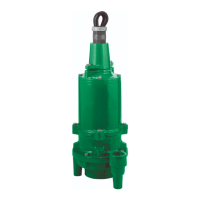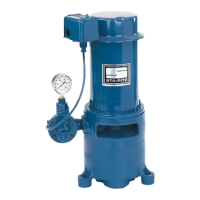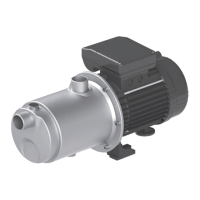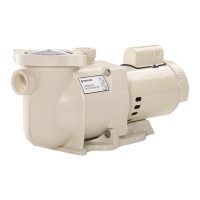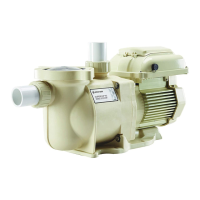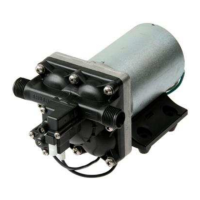26850A002 06/04/14
14
5. If the pressure regulator internal bypass valve is
worn, it will allow too much of the pump capacity to
be bypassed and recirculated back to the tank. By
examining the flow from this valve with the discharge
turned on, it can be determined whether or not the valve
is worn. If a heavy flow continues when the discharge is
turned on, it is usually a good indication of a worn valve
and should be replaced.
6. A broken pump valve or spring will often prevent one
cylinder from functioning properly resulting in a rough
pulsing discharge, a knocking sound and a loss of
capacity. If not repaired immediately, the rough running
pump can cause mechanical damage to itself or other
system components.
7. Worn packing, valves or valve seats will cause a severe
drop in pump capacity pressure. Worn packing is
detected by water leakage and should be replaced
immediately. Water getting in the pump crankcase
will cause severe corrosion of the bearings and cause
rapid wear. Worn valves can be detected by visual
examination of each valve assembly. Abrasive liquid will
cause wire cuts which begin as a very small groove, but
increases rapidly once the valve starts to leak through
this groove. If the valves are replaced as soon as they
start to show this cutting action, it will prevent the valve
seat from becoming cut in a similar manner.
8. If a portion of the pump delivery is allowed to bypass
because the #1 control valve is not completely
closed, there may not be adequate flow to develop
full pressure. This will cause rapid wear in the control
valve. Any excess flow should be bypassed only by the
pressure regulator.
9. Pump cylinder bodies withstand an extreme amount
of shock and pulsation while in operation. If the
pump is allowed to freeze, by not being drained, the
freezing may crack the cylinder body walls in almost
any location. If the crack occurs on the suction valve
or cylinder portion of the body, it may allow a small
amount of air to enter on the suction stroke and cause
noisy operation or a decrease in pumping capacity. If
the crack develops in the walls between the cylinder
cavities or discharge valve cavity, it may allow the water
to flow from one cavity to the adjacent cavity and cause
uneven displacement.
10. Water may accumulate in the pump crankcase from
two sources; leakage of packing or an accumulation
of condensation/moisture inside the crankcase due to
changes in weather or the repeated heating and cooling
of the pump. Pumps used consistently, running for a
considerable period of time to heat the oil and other
working parts, will not normally accumulate water by
condensation. Replace the packing as soon as it starts
to leak.
11. Worn connecting link bearings are caused by
unusual or adverse operating conditions and are
seriously affected by corrosion if water is present in
the crankcase. They will wear out from overheating if
the oil is not high quality or clean. Drain, clean and
refill with new oil at the specified interval and prior
to any storage period. Replace link inserts as soon
as any wear is noticed to avoid damage to
crankshaft journals.
12. Low oil in the crankcase can quickly cause failure of
the pumps power end and result in extensive repairs.
Oil level should be checked periodically during normal
operation and during all maintenance work.
13. A foaming mixture will sometimes have the same
effect as a small air leak in the suction line. This is
because various quantities of the foam are drawn
through the suction line into the pump disrupting the
normal flow of water.
14. Pressure regulators can become sluggish due to the
plunger sticking or fitting too tightly in the cylinder.
This may happen by an accumulation of chemicals
collecting in and around the plunger or from excessive
corrosion of the plunger parts. To check this condition,
remove and clean the plunger and cover the parts with
a waterproof grease before assembling. The pressure
regulator may chatter or vibrate excessively due to
an unstable operation from nozzling in the high or low
capacity range of the regulator. The range should be at
least 50% to 90% of pump capacity.
15. If foreign matter becomes lodged between the pump
valve and valve seat, a drastic drop in capacity and
considerable surge or pulsation will occur in the
discharge line. Examine each valve if this occurs.
16. Noisy pump operation may be caused by a loose piston
rod in the crosshead. This noise usually has a regular
cadence timed with each stroke. If this happens, always
replace both the rod and the crosshead.
17. Increased preload to the crankshaft bearings will reduce
bearing life, require more power and generate more
heat. Insufficient preload may cause a knock, timed with
the crankshaft rotation. Check for loose bolts on the
crankshaft end caps or adjust shims to obtain proper
bearing preload. Worn roller bearings will continue to
run but will introduce wear particles into the oil.
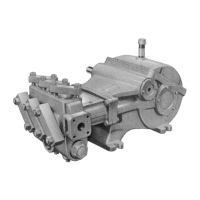
